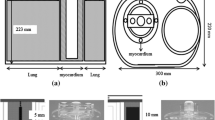Abstract
When projection data are incomplete for various technical reasons, artefacts may occur in the reconstructed images. This study examines whether an iterative reconstruction method, the ordered subsets implementation of the EM algorithm (OSEM), can improve reconstruction and minimise the artefacts compared to filtered back-projection (FBP). We varied the number and location of projections removed to investigate when significant artefacts occur, and whether diagnosis is affected. Phantom studies were analysed with sequential orthogonal pairs of projection angles removed (as would typically occur when either data loss or severe motion is detected during acquisition with a right-angled, dual-head cardiac single-photon emission tomography system) and reconstructed with both FBP and OSEM. Twelve normal myocardial perfusion studies were also assessed to study the effect of missing projections on clinical diagnosis. Differences between reconstructions with intact versus missing data were measured. Also, reconstructed images were clinically assessed and scored on a five-point scale based on whether the artefacts would alter clinical interpretation. Although both reconstruction methods showed artefacts, the absolute differences between reconstructed phantom data with intact and missing projection sets were significantly greater (P<0.005) for FBP than for OSEM for all numbers of missing projections. The clinical data showed similar differences between FBP and OSEM reconstructions. The three observers noted superiority of OSEM compared to FBP, with reduced incidence of clinically significant artefacts. However, neither reconstruction method could tolerate six or more missing pairs from 32 projections. There was no significant dependence on the angular location of missing projections. In the absence of any attempt to correct for missing projections, OSEM reduced the influence of artefacts compared to FBP.





Similar content being viewed by others
References
Germano G, Kavanagh PB, Kiat H, Van Train K, Berman DS. Temporal image fractionation: rejection of motion artifacts in myocardial SPECT. J Nucl Med 1994; 35:1193–1197.
Ollinger JM. Iterative reconstruction-reprojection and the expectation-maximization algorithm. IEEE Trans Med Imaging 1990; 9:94–98.
Baghaei H, Li H, Uribe J, Wang Y, Wong W-H. Compensation of missing projection data for MDAPET camera. Nuclear Science Symposium Conference Record 2000; 3:17/41–17/45.
Karp JS, Muehllehner G, Lewitt RM. Constrained Fourier space method for compensation of missing data in emission computed tomography. IEEE Trans Nucl Sci 1988; 7:21–25.
Andersen AH. Algebraic reconstruction in CT from limited views. IEEE Trans Med Imag 1989; 8:50–55.
Gore JC, Leeman S. The reconstruction of objects from incomplete projections. Phys Med Biol 1980; 1:129–136.
Lange K, Carson R. EM reconstruction algorithms for emission and transmission tomography. J Comput Assist Tomogr 1984; 8:306–316.
Kinahan PE, Fessler JA, Karp JS. Statistical reconstruction in PET with compensation for missing data. IEEE Trans Med Imaging 1997; 44:1552–1557.
Hudson HM, Larkin RS. Accelerated image reconstruction using ordered subsets of projection data. IEEE Trans Med Imaging 1994; 13:601–609.
Segars WP, Lalush DS, Tsui BMW. A realistic spline-based dynamic heart phantom. IEEE Trans Nucl Sci 1999; 46:503–506.
DePuey EG. How to detect and avoid myocardial perfusion SPECT artifacts. J Nucl Med 1994; 35:699–702.
Author information
Authors and Affiliations
Corresponding author
Rights and permissions
About this article
Cite this article
Hatton, R.L., Hutton, B.F., Angelides, S. et al. Improved tolerance to missing data in myocardial perfusion SPET using OSEM reconstruction. Eur J Nucl Med Mol Imaging 31, 857–861 (2004). https://doi.org/10.1007/s00259-003-1450-4
Received:
Accepted:
Published:
Issue Date:
DOI: https://doi.org/10.1007/s00259-003-1450-4




